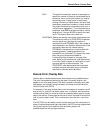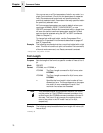
Execute Form: Overlay Data
67
RST
n
The optional incremental reset count parameter to
specify the number of times an incremented field is
printed (on one or more forms) before it is reset to
the starting value. A reset count is useful when
printing a hierarchy of fields where a low-level field
generates a sequence of numbers, is reset, and the
next higher field level is incremented (such as in a
unit/box/carton application). To use the reset count
parameter, enter RST and replace
n
with a number
ranging from 1 through 65,535 to specify the reset
count. The default reset count value is 0.
STARTDATA
Defines the starting value of the incrementing field.
The maximum amount of STARTDATA characters
must be equal to or less than the number of
characters in the STEPMASK field. If the number of
data characters in the Dynamic Alphanumeric Data
command is less than the number used in
STEPMASK, the data will print right justified with
preceding spaces. (Leading spaces are not
provided for bar code data.) For dynamic bar code
data, the type of characters allowed for
incrementing fields is based on the type of bar
code. Refer to the individual bar code descriptions
in the “Bar Codes” chapter for information on valid
type and quantity of data characters. The
STARTDATA must be enclosed within standard
printable character delimiters just as a standard
data field is enclosed within delimiters.
Execute Form: Overlay Data
Overlay data is variable alphanumeric data entered onto a predefined form.
The form is completed by positioning the data in the exact location it will
appear on the form when printed. The data is placed horizontally using tabs
and spaces, and vertically using line feeds, form feeds, and the Electronic
Vertical Format Unit (EVFU).
For example, if the serial number field on the form begins at character row 22
and column 14, enter 22 line feeds, space over 14 columns, and input serial
number overlay data. An entire form can be completed with a page of overlay
data in this manner. Overlay data at the end of a form is printed on a new form
until all overlay data is used. Then, to advance to the next form, use a form
feed.
The IGP EVFU can be used to control vertical spacing of the overlay data. In
place of line feed commands input individually, the EVFU can be programmed
(during the Execute Form mode) to slew the overlay data to the
predetermined line with a single command.


















